Analyzing Communication Strategies in Health and Social Care Report
VerifiedAdded on 2020/01/23
|13
|3435
|68
Report
AI Summary
This report delves into the crucial aspects of communication within healthcare and social care settings. It begins by examining the psychoanalytic theory of communication and its application, highlighting its strengths and weaknesses, and then moves on to discuss various communication skills, including verbal, non-verbal, and written forms, essential for interacting with different service users such as patients, coworkers, and family members. The report also addresses inappropriate interpersonal communication, such as language barriers and misinterpretations, and proposes pre-emptive and reactive methods to mitigate these issues. It further explores strategies for supporting individuals with complex health needs, like assistive technologies and human strategies. The report also discusses the impact of cultural factors, legislation, charters, and organizational policies on the communication process, emphasizing the importance of respect, dignity, and data protection. Finally, the report suggests ways to improve communication, such as utilizing CRM software and implementing effective organizational systems. Overall, the report provides a comprehensive overview of communication challenges and best practices in health and social care environments.
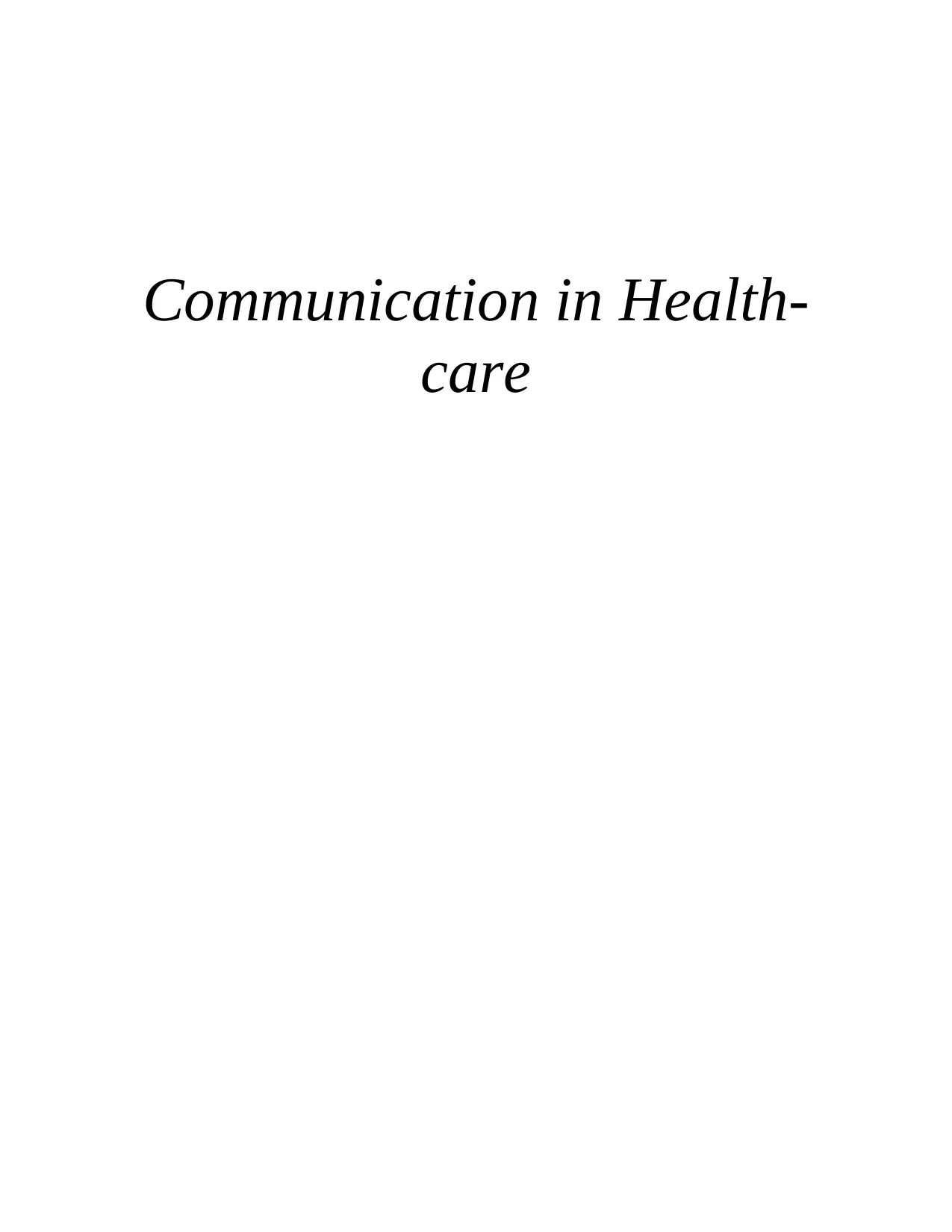
Communication in Health-
care
care
Paraphrase This Document
Need a fresh take? Get an instant paraphrase of this document with our AI Paraphraser
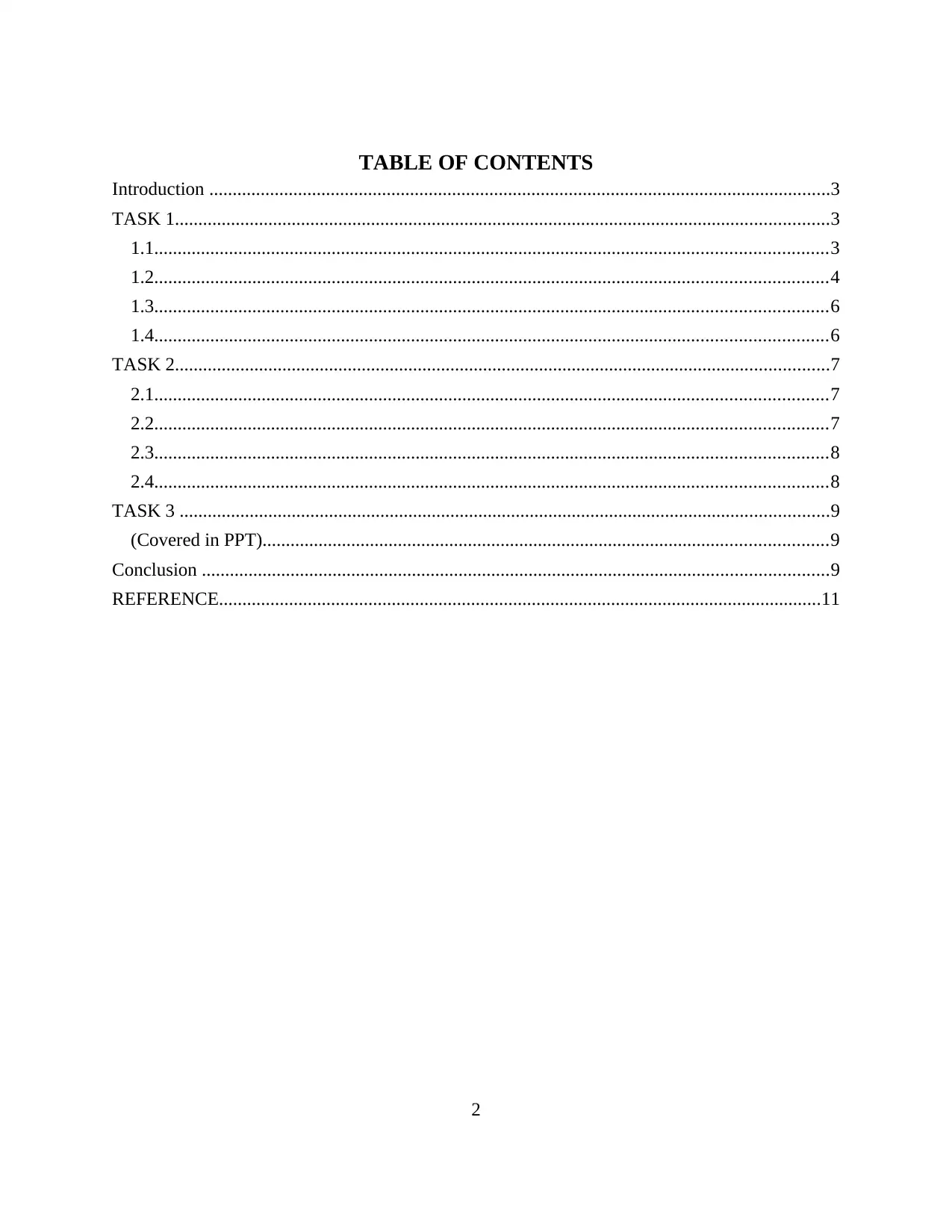
TABLE OF CONTENTS
Introduction .....................................................................................................................................3
TASK 1............................................................................................................................................3
1.1................................................................................................................................................3
1.2................................................................................................................................................4
1.3................................................................................................................................................6
1.4................................................................................................................................................6
TASK 2............................................................................................................................................7
2.1................................................................................................................................................7
2.2................................................................................................................................................7
2.3................................................................................................................................................8
2.4................................................................................................................................................8
TASK 3 ...........................................................................................................................................9
(Covered in PPT).........................................................................................................................9
Conclusion ......................................................................................................................................9
REFERENCE.................................................................................................................................11
2
Introduction .....................................................................................................................................3
TASK 1............................................................................................................................................3
1.1................................................................................................................................................3
1.2................................................................................................................................................4
1.3................................................................................................................................................6
1.4................................................................................................................................................6
TASK 2............................................................................................................................................7
2.1................................................................................................................................................7
2.2................................................................................................................................................7
2.3................................................................................................................................................8
2.4................................................................................................................................................8
TASK 3 ...........................................................................................................................................9
(Covered in PPT).........................................................................................................................9
Conclusion ......................................................................................................................................9
REFERENCE.................................................................................................................................11
2
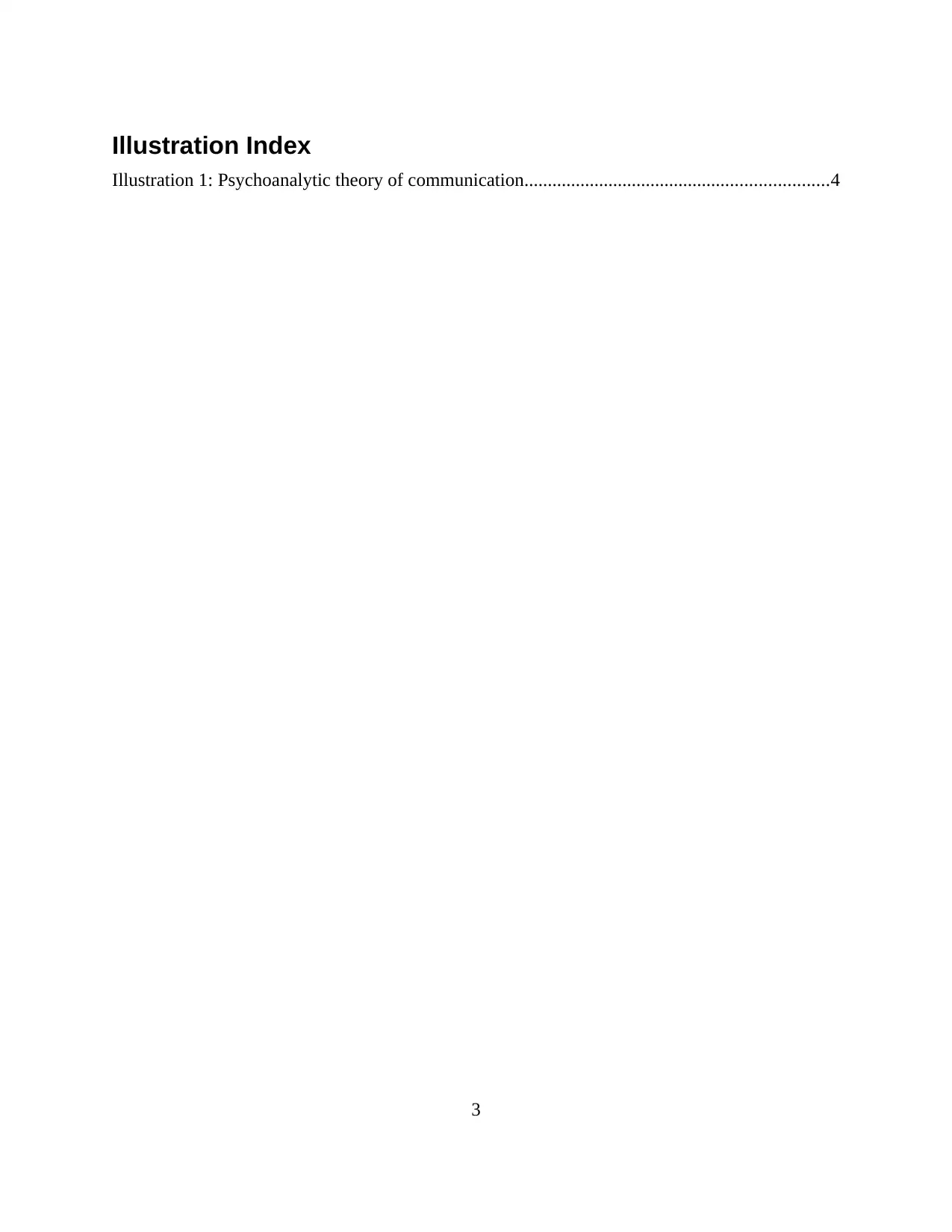
Illustration Index
Illustration 1: Psychoanalytic theory of communication.................................................................4
3
Illustration 1: Psychoanalytic theory of communication.................................................................4
3
⊘ This is a preview!⊘
Do you want full access?
Subscribe today to unlock all pages.

Trusted by 1+ million students worldwide
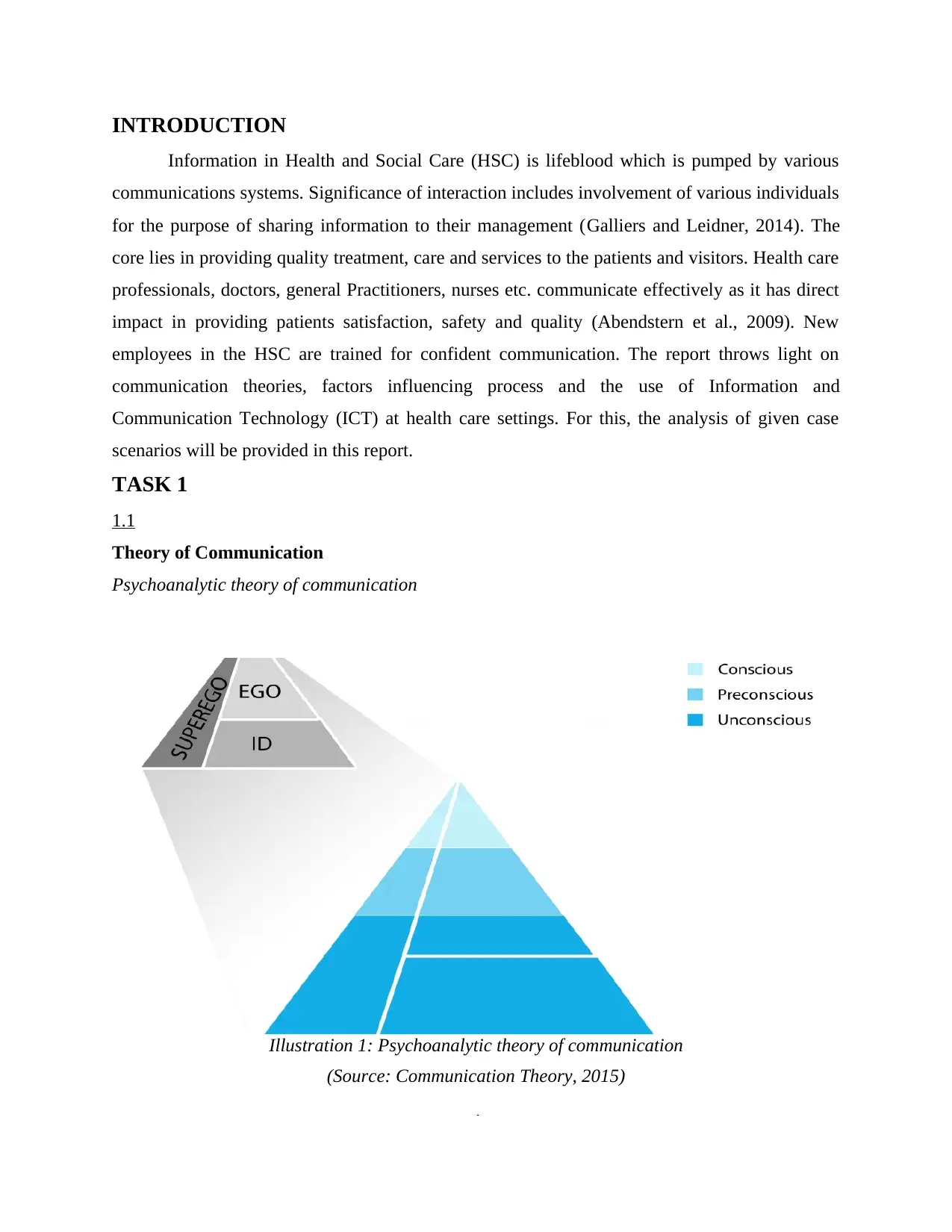
INTRODUCTION
Information in Health and Social Care (HSC) is lifeblood which is pumped by various
communications systems. Significance of interaction includes involvement of various individuals
for the purpose of sharing information to their management (Galliers and Leidner, 2014). The
core lies in providing quality treatment, care and services to the patients and visitors. Health care
professionals, doctors, general Practitioners, nurses etc. communicate effectively as it has direct
impact in providing patients satisfaction, safety and quality (Abendstern et al., 2009). New
employees in the HSC are trained for confident communication. The report throws light on
communication theories, factors influencing process and the use of Information and
Communication Technology (ICT) at health care settings. For this, the analysis of given case
scenarios will be provided in this report.
TASK 1
1.1
Theory of Communication
Psychoanalytic theory of communication
4
Illustration 1: Psychoanalytic theory of communication
(Source: Communication Theory, 2015)
Information in Health and Social Care (HSC) is lifeblood which is pumped by various
communications systems. Significance of interaction includes involvement of various individuals
for the purpose of sharing information to their management (Galliers and Leidner, 2014). The
core lies in providing quality treatment, care and services to the patients and visitors. Health care
professionals, doctors, general Practitioners, nurses etc. communicate effectively as it has direct
impact in providing patients satisfaction, safety and quality (Abendstern et al., 2009). New
employees in the HSC are trained for confident communication. The report throws light on
communication theories, factors influencing process and the use of Information and
Communication Technology (ICT) at health care settings. For this, the analysis of given case
scenarios will be provided in this report.
TASK 1
1.1
Theory of Communication
Psychoanalytic theory of communication
4
Illustration 1: Psychoanalytic theory of communication
(Source: Communication Theory, 2015)
Paraphrase This Document
Need a fresh take? Get an instant paraphrase of this document with our AI Paraphraser
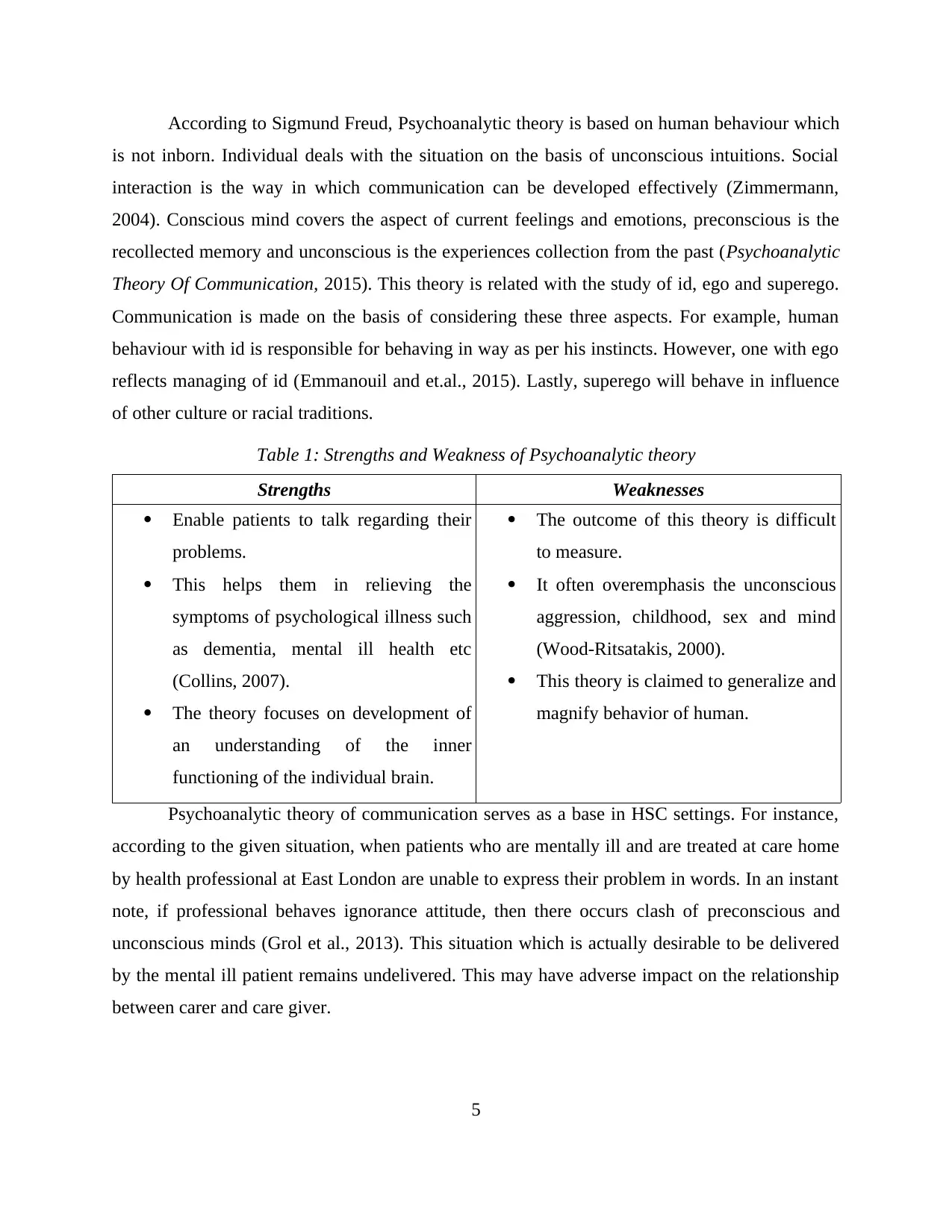
According to Sigmund Freud, Psychoanalytic theory is based on human behaviour which
is not inborn. Individual deals with the situation on the basis of unconscious intuitions. Social
interaction is the way in which communication can be developed effectively (Zimmermann,
2004). Conscious mind covers the aspect of current feelings and emotions, preconscious is the
recollected memory and unconscious is the experiences collection from the past (Psychoanalytic
Theory Of Communication, 2015). This theory is related with the study of id, ego and superego.
Communication is made on the basis of considering these three aspects. For example, human
behaviour with id is responsible for behaving in way as per his instincts. However, one with ego
reflects managing of id (Emmanouil and et.al., 2015). Lastly, superego will behave in influence
of other culture or racial traditions.
Table 1: Strengths and Weakness of Psychoanalytic theory
Strengths Weaknesses
Enable patients to talk regarding their
problems.
This helps them in relieving the
symptoms of psychological illness such
as dementia, mental ill health etc
(Collins, 2007).
The theory focuses on development of
an understanding of the inner
functioning of the individual brain.
The outcome of this theory is difficult
to measure.
It often overemphasis the unconscious
aggression, childhood, sex and mind
(Wood-Ritsatakis, 2000).
This theory is claimed to generalize and
magnify behavior of human.
Psychoanalytic theory of communication serves as a base in HSC settings. For instance,
according to the given situation, when patients who are mentally ill and are treated at care home
by health professional at East London are unable to express their problem in words. In an instant
note, if professional behaves ignorance attitude, then there occurs clash of preconscious and
unconscious minds (Grol et al., 2013). This situation which is actually desirable to be delivered
by the mental ill patient remains undelivered. This may have adverse impact on the relationship
between carer and care giver.
5
is not inborn. Individual deals with the situation on the basis of unconscious intuitions. Social
interaction is the way in which communication can be developed effectively (Zimmermann,
2004). Conscious mind covers the aspect of current feelings and emotions, preconscious is the
recollected memory and unconscious is the experiences collection from the past (Psychoanalytic
Theory Of Communication, 2015). This theory is related with the study of id, ego and superego.
Communication is made on the basis of considering these three aspects. For example, human
behaviour with id is responsible for behaving in way as per his instincts. However, one with ego
reflects managing of id (Emmanouil and et.al., 2015). Lastly, superego will behave in influence
of other culture or racial traditions.
Table 1: Strengths and Weakness of Psychoanalytic theory
Strengths Weaknesses
Enable patients to talk regarding their
problems.
This helps them in relieving the
symptoms of psychological illness such
as dementia, mental ill health etc
(Collins, 2007).
The theory focuses on development of
an understanding of the inner
functioning of the individual brain.
The outcome of this theory is difficult
to measure.
It often overemphasis the unconscious
aggression, childhood, sex and mind
(Wood-Ritsatakis, 2000).
This theory is claimed to generalize and
magnify behavior of human.
Psychoanalytic theory of communication serves as a base in HSC settings. For instance,
according to the given situation, when patients who are mentally ill and are treated at care home
by health professional at East London are unable to express their problem in words. In an instant
note, if professional behaves ignorance attitude, then there occurs clash of preconscious and
unconscious minds (Grol et al., 2013). This situation which is actually desirable to be delivered
by the mental ill patient remains undelivered. This may have adverse impact on the relationship
between carer and care giver.
5
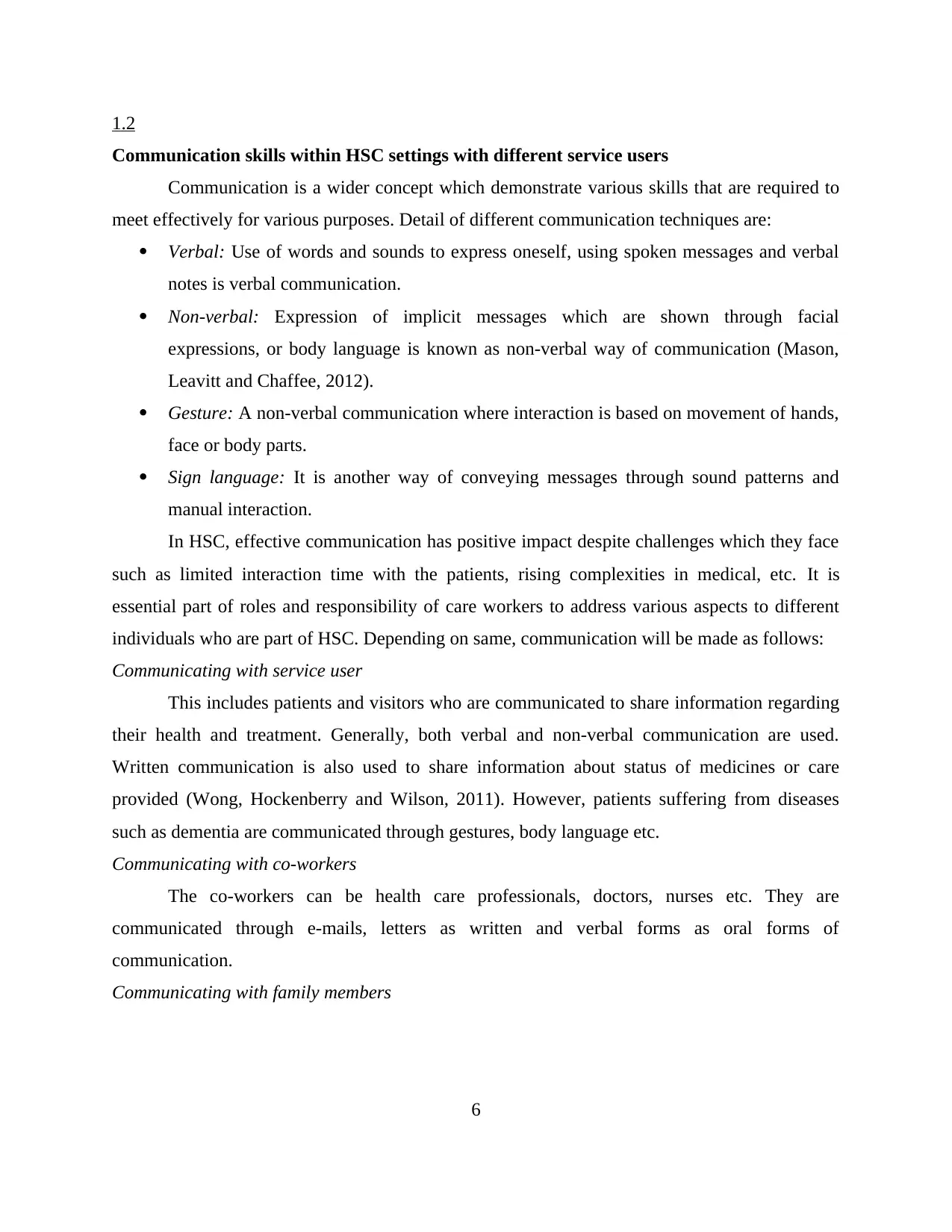
1.2
Communication skills within HSC settings with different service users
Communication is a wider concept which demonstrate various skills that are required to
meet effectively for various purposes. Detail of different communication techniques are:
Verbal: Use of words and sounds to express oneself, using spoken messages and verbal
notes is verbal communication.
Non-verbal: Expression of implicit messages which are shown through facial
expressions, or body language is known as non-verbal way of communication (Mason,
Leavitt and Chaffee, 2012).
Gesture: A non-verbal communication where interaction is based on movement of hands,
face or body parts.
Sign language: It is another way of conveying messages through sound patterns and
manual interaction.
In HSC, effective communication has positive impact despite challenges which they face
such as limited interaction time with the patients, rising complexities in medical, etc. It is
essential part of roles and responsibility of care workers to address various aspects to different
individuals who are part of HSC. Depending on same, communication will be made as follows:
Communicating with service user
This includes patients and visitors who are communicated to share information regarding
their health and treatment. Generally, both verbal and non-verbal communication are used.
Written communication is also used to share information about status of medicines or care
provided (Wong, Hockenberry and Wilson, 2011). However, patients suffering from diseases
such as dementia are communicated through gestures, body language etc.
Communicating with co-workers
The co-workers can be health care professionals, doctors, nurses etc. They are
communicated through e-mails, letters as written and verbal forms as oral forms of
communication.
Communicating with family members
6
Communication skills within HSC settings with different service users
Communication is a wider concept which demonstrate various skills that are required to
meet effectively for various purposes. Detail of different communication techniques are:
Verbal: Use of words and sounds to express oneself, using spoken messages and verbal
notes is verbal communication.
Non-verbal: Expression of implicit messages which are shown through facial
expressions, or body language is known as non-verbal way of communication (Mason,
Leavitt and Chaffee, 2012).
Gesture: A non-verbal communication where interaction is based on movement of hands,
face or body parts.
Sign language: It is another way of conveying messages through sound patterns and
manual interaction.
In HSC, effective communication has positive impact despite challenges which they face
such as limited interaction time with the patients, rising complexities in medical, etc. It is
essential part of roles and responsibility of care workers to address various aspects to different
individuals who are part of HSC. Depending on same, communication will be made as follows:
Communicating with service user
This includes patients and visitors who are communicated to share information regarding
their health and treatment. Generally, both verbal and non-verbal communication are used.
Written communication is also used to share information about status of medicines or care
provided (Wong, Hockenberry and Wilson, 2011). However, patients suffering from diseases
such as dementia are communicated through gestures, body language etc.
Communicating with co-workers
The co-workers can be health care professionals, doctors, nurses etc. They are
communicated through e-mails, letters as written and verbal forms as oral forms of
communication.
Communicating with family members
6
⊘ This is a preview!⊘
Do you want full access?
Subscribe today to unlock all pages.

Trusted by 1+ million students worldwide
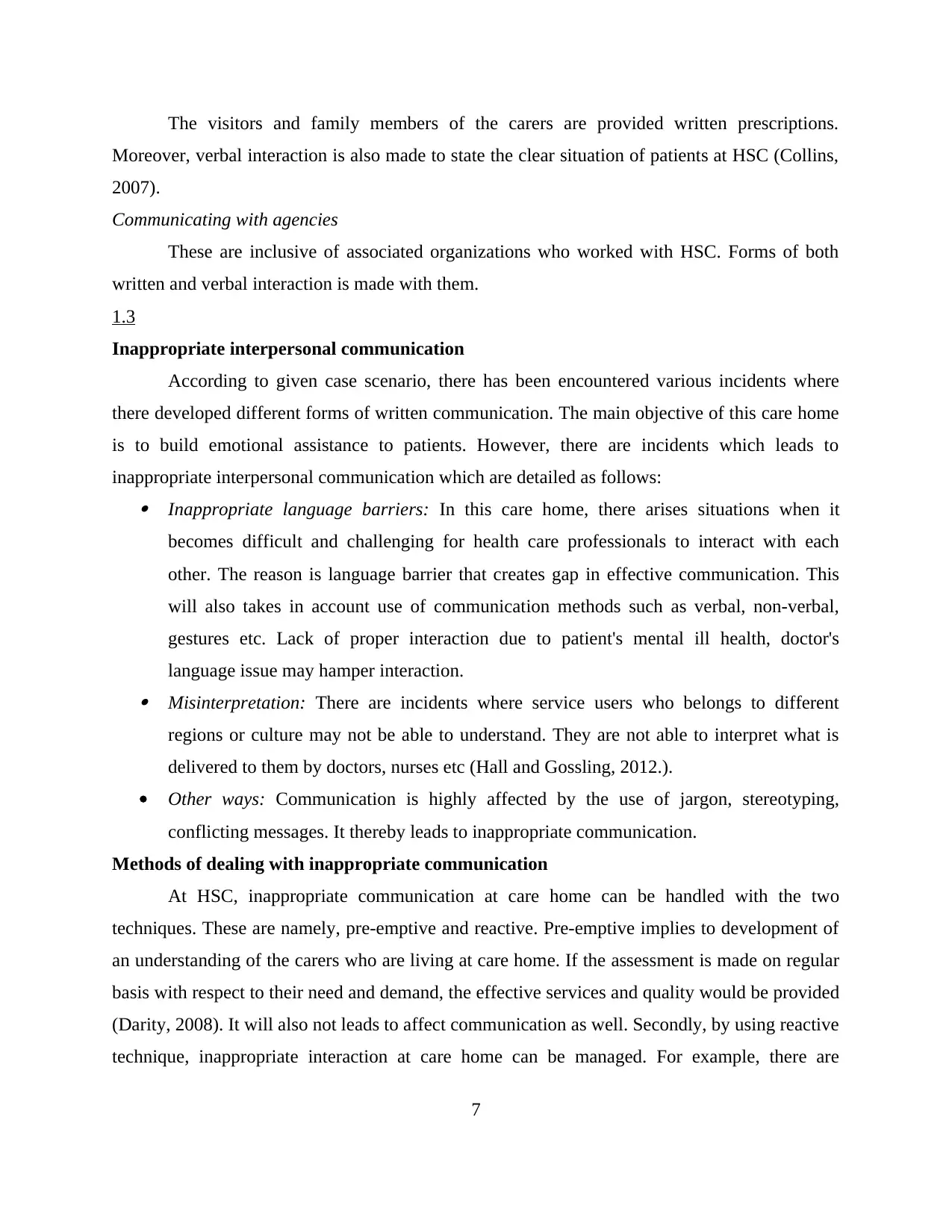
The visitors and family members of the carers are provided written prescriptions.
Moreover, verbal interaction is also made to state the clear situation of patients at HSC (Collins,
2007).
Communicating with agencies
These are inclusive of associated organizations who worked with HSC. Forms of both
written and verbal interaction is made with them.
1.3
Inappropriate interpersonal communication
According to given case scenario, there has been encountered various incidents where
there developed different forms of written communication. The main objective of this care home
is to build emotional assistance to patients. However, there are incidents which leads to
inappropriate interpersonal communication which are detailed as follows: Inappropriate language barriers: In this care home, there arises situations when it
becomes difficult and challenging for health care professionals to interact with each
other. The reason is language barrier that creates gap in effective communication. This
will also takes in account use of communication methods such as verbal, non-verbal,
gestures etc. Lack of proper interaction due to patient's mental ill health, doctor's
language issue may hamper interaction. Misinterpretation: There are incidents where service users who belongs to different
regions or culture may not be able to understand. They are not able to interpret what is
delivered to them by doctors, nurses etc (Hall and Gossling, 2012.).
Other ways: Communication is highly affected by the use of jargon, stereotyping,
conflicting messages. It thereby leads to inappropriate communication.
Methods of dealing with inappropriate communication
At HSC, inappropriate communication at care home can be handled with the two
techniques. These are namely, pre-emptive and reactive. Pre-emptive implies to development of
an understanding of the carers who are living at care home. If the assessment is made on regular
basis with respect to their need and demand, the effective services and quality would be provided
(Darity, 2008). It will also not leads to affect communication as well. Secondly, by using reactive
technique, inappropriate interaction at care home can be managed. For example, there are
7
Moreover, verbal interaction is also made to state the clear situation of patients at HSC (Collins,
2007).
Communicating with agencies
These are inclusive of associated organizations who worked with HSC. Forms of both
written and verbal interaction is made with them.
1.3
Inappropriate interpersonal communication
According to given case scenario, there has been encountered various incidents where
there developed different forms of written communication. The main objective of this care home
is to build emotional assistance to patients. However, there are incidents which leads to
inappropriate interpersonal communication which are detailed as follows: Inappropriate language barriers: In this care home, there arises situations when it
becomes difficult and challenging for health care professionals to interact with each
other. The reason is language barrier that creates gap in effective communication. This
will also takes in account use of communication methods such as verbal, non-verbal,
gestures etc. Lack of proper interaction due to patient's mental ill health, doctor's
language issue may hamper interaction. Misinterpretation: There are incidents where service users who belongs to different
regions or culture may not be able to understand. They are not able to interpret what is
delivered to them by doctors, nurses etc (Hall and Gossling, 2012.).
Other ways: Communication is highly affected by the use of jargon, stereotyping,
conflicting messages. It thereby leads to inappropriate communication.
Methods of dealing with inappropriate communication
At HSC, inappropriate communication at care home can be handled with the two
techniques. These are namely, pre-emptive and reactive. Pre-emptive implies to development of
an understanding of the carers who are living at care home. If the assessment is made on regular
basis with respect to their need and demand, the effective services and quality would be provided
(Darity, 2008). It will also not leads to affect communication as well. Secondly, by using reactive
technique, inappropriate interaction at care home can be managed. For example, there are
7
Paraphrase This Document
Need a fresh take? Get an instant paraphrase of this document with our AI Paraphraser
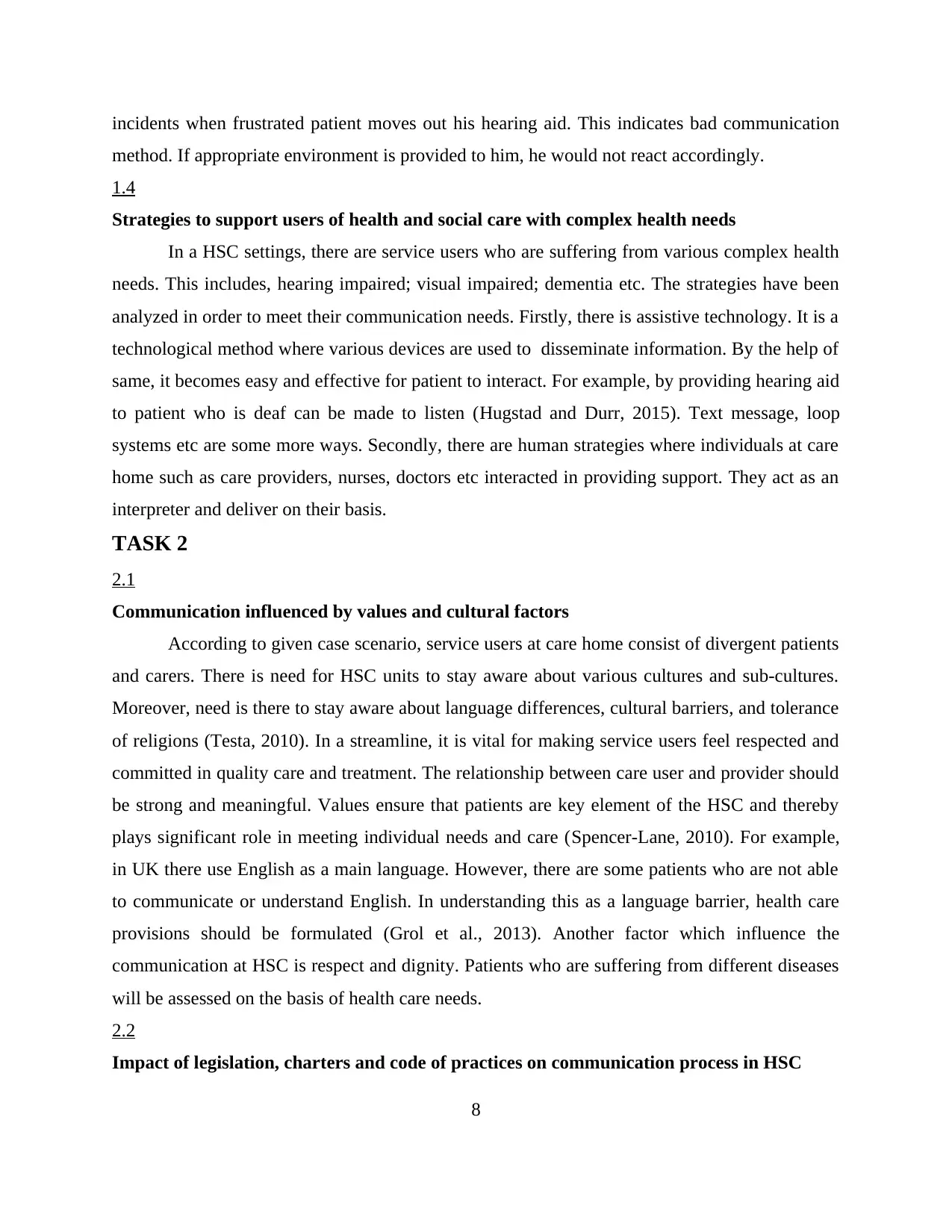
incidents when frustrated patient moves out his hearing aid. This indicates bad communication
method. If appropriate environment is provided to him, he would not react accordingly.
1.4
Strategies to support users of health and social care with complex health needs
In a HSC settings, there are service users who are suffering from various complex health
needs. This includes, hearing impaired; visual impaired; dementia etc. The strategies have been
analyzed in order to meet their communication needs. Firstly, there is assistive technology. It is a
technological method where various devices are used to disseminate information. By the help of
same, it becomes easy and effective for patient to interact. For example, by providing hearing aid
to patient who is deaf can be made to listen (Hugstad and Durr, 2015). Text message, loop
systems etc are some more ways. Secondly, there are human strategies where individuals at care
home such as care providers, nurses, doctors etc interacted in providing support. They act as an
interpreter and deliver on their basis.
TASK 2
2.1
Communication influenced by values and cultural factors
According to given case scenario, service users at care home consist of divergent patients
and carers. There is need for HSC units to stay aware about various cultures and sub-cultures.
Moreover, need is there to stay aware about language differences, cultural barriers, and tolerance
of religions (Testa, 2010). In a streamline, it is vital for making service users feel respected and
committed in quality care and treatment. The relationship between care user and provider should
be strong and meaningful. Values ensure that patients are key element of the HSC and thereby
plays significant role in meeting individual needs and care (Spencer‐Lane, 2010). For example,
in UK there use English as a main language. However, there are some patients who are not able
to communicate or understand English. In understanding this as a language barrier, health care
provisions should be formulated (Grol et al., 2013). Another factor which influence the
communication at HSC is respect and dignity. Patients who are suffering from different diseases
will be assessed on the basis of health care needs.
2.2
Impact of legislation, charters and code of practices on communication process in HSC
8
method. If appropriate environment is provided to him, he would not react accordingly.
1.4
Strategies to support users of health and social care with complex health needs
In a HSC settings, there are service users who are suffering from various complex health
needs. This includes, hearing impaired; visual impaired; dementia etc. The strategies have been
analyzed in order to meet their communication needs. Firstly, there is assistive technology. It is a
technological method where various devices are used to disseminate information. By the help of
same, it becomes easy and effective for patient to interact. For example, by providing hearing aid
to patient who is deaf can be made to listen (Hugstad and Durr, 2015). Text message, loop
systems etc are some more ways. Secondly, there are human strategies where individuals at care
home such as care providers, nurses, doctors etc interacted in providing support. They act as an
interpreter and deliver on their basis.
TASK 2
2.1
Communication influenced by values and cultural factors
According to given case scenario, service users at care home consist of divergent patients
and carers. There is need for HSC units to stay aware about various cultures and sub-cultures.
Moreover, need is there to stay aware about language differences, cultural barriers, and tolerance
of religions (Testa, 2010). In a streamline, it is vital for making service users feel respected and
committed in quality care and treatment. The relationship between care user and provider should
be strong and meaningful. Values ensure that patients are key element of the HSC and thereby
plays significant role in meeting individual needs and care (Spencer‐Lane, 2010). For example,
in UK there use English as a main language. However, there are some patients who are not able
to communicate or understand English. In understanding this as a language barrier, health care
provisions should be formulated (Grol et al., 2013). Another factor which influence the
communication at HSC is respect and dignity. Patients who are suffering from different diseases
will be assessed on the basis of health care needs.
2.2
Impact of legislation, charters and code of practices on communication process in HSC
8
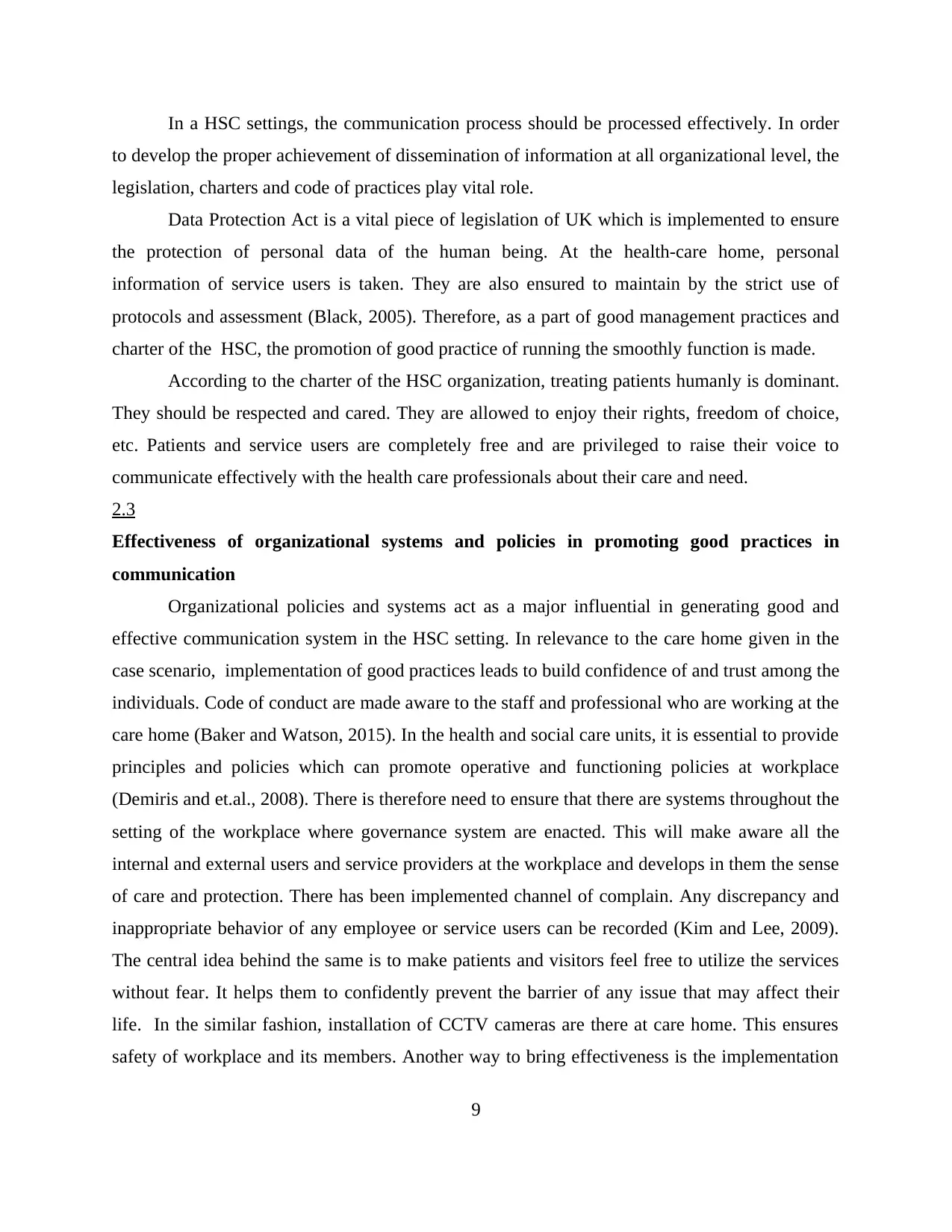
In a HSC settings, the communication process should be processed effectively. In order
to develop the proper achievement of dissemination of information at all organizational level, the
legislation, charters and code of practices play vital role.
Data Protection Act is a vital piece of legislation of UK which is implemented to ensure
the protection of personal data of the human being. At the health-care home, personal
information of service users is taken. They are also ensured to maintain by the strict use of
protocols and assessment (Black, 2005). Therefore, as a part of good management practices and
charter of the HSC, the promotion of good practice of running the smoothly function is made.
According to the charter of the HSC organization, treating patients humanly is dominant.
They should be respected and cared. They are allowed to enjoy their rights, freedom of choice,
etc. Patients and service users are completely free and are privileged to raise their voice to
communicate effectively with the health care professionals about their care and need.
2.3
Effectiveness of organizational systems and policies in promoting good practices in
communication
Organizational policies and systems act as a major influential in generating good and
effective communication system in the HSC setting. In relevance to the care home given in the
case scenario, implementation of good practices leads to build confidence of and trust among the
individuals. Code of conduct are made aware to the staff and professional who are working at the
care home (Baker and Watson, 2015). In the health and social care units, it is essential to provide
principles and policies which can promote operative and functioning policies at workplace
(Demiris and et.al., 2008). There is therefore need to ensure that there are systems throughout the
setting of the workplace where governance system are enacted. This will make aware all the
internal and external users and service providers at the workplace and develops in them the sense
of care and protection. There has been implemented channel of complain. Any discrepancy and
inappropriate behavior of any employee or service users can be recorded (Kim and Lee, 2009).
The central idea behind the same is to make patients and visitors feel free to utilize the services
without fear. It helps them to confidently prevent the barrier of any issue that may affect their
life. In the similar fashion, installation of CCTV cameras are there at care home. This ensures
safety of workplace and its members. Another way to bring effectiveness is the implementation
9
to develop the proper achievement of dissemination of information at all organizational level, the
legislation, charters and code of practices play vital role.
Data Protection Act is a vital piece of legislation of UK which is implemented to ensure
the protection of personal data of the human being. At the health-care home, personal
information of service users is taken. They are also ensured to maintain by the strict use of
protocols and assessment (Black, 2005). Therefore, as a part of good management practices and
charter of the HSC, the promotion of good practice of running the smoothly function is made.
According to the charter of the HSC organization, treating patients humanly is dominant.
They should be respected and cared. They are allowed to enjoy their rights, freedom of choice,
etc. Patients and service users are completely free and are privileged to raise their voice to
communicate effectively with the health care professionals about their care and need.
2.3
Effectiveness of organizational systems and policies in promoting good practices in
communication
Organizational policies and systems act as a major influential in generating good and
effective communication system in the HSC setting. In relevance to the care home given in the
case scenario, implementation of good practices leads to build confidence of and trust among the
individuals. Code of conduct are made aware to the staff and professional who are working at the
care home (Baker and Watson, 2015). In the health and social care units, it is essential to provide
principles and policies which can promote operative and functioning policies at workplace
(Demiris and et.al., 2008). There is therefore need to ensure that there are systems throughout the
setting of the workplace where governance system are enacted. This will make aware all the
internal and external users and service providers at the workplace and develops in them the sense
of care and protection. There has been implemented channel of complain. Any discrepancy and
inappropriate behavior of any employee or service users can be recorded (Kim and Lee, 2009).
The central idea behind the same is to make patients and visitors feel free to utilize the services
without fear. It helps them to confidently prevent the barrier of any issue that may affect their
life. In the similar fashion, installation of CCTV cameras are there at care home. This ensures
safety of workplace and its members. Another way to bring effectiveness is the implementation
9
⊘ This is a preview!⊘
Do you want full access?
Subscribe today to unlock all pages.

Trusted by 1+ million students worldwide
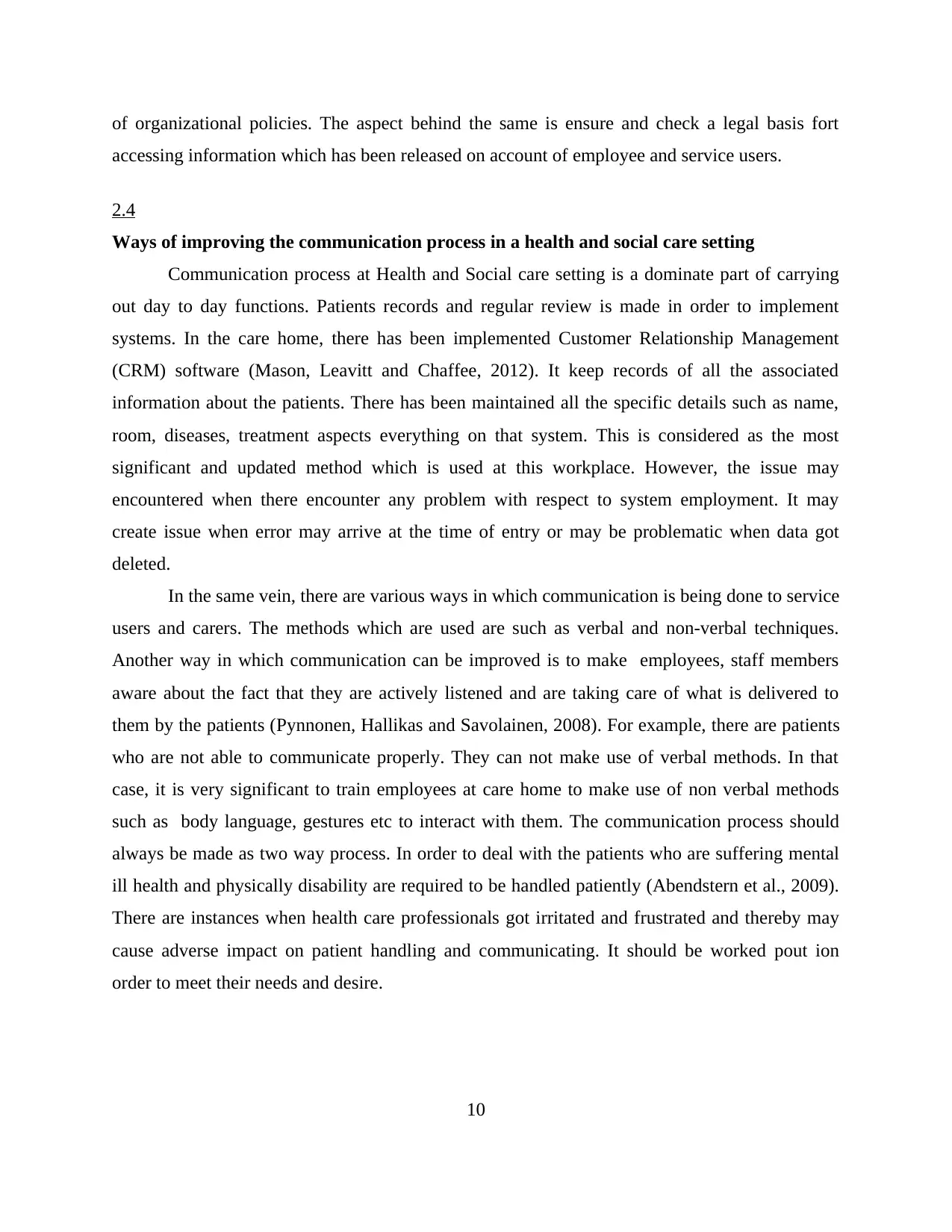
of organizational policies. The aspect behind the same is ensure and check a legal basis fort
accessing information which has been released on account of employee and service users.
2.4
Ways of improving the communication process in a health and social care setting
Communication process at Health and Social care setting is a dominate part of carrying
out day to day functions. Patients records and regular review is made in order to implement
systems. In the care home, there has been implemented Customer Relationship Management
(CRM) software (Mason, Leavitt and Chaffee, 2012). It keep records of all the associated
information about the patients. There has been maintained all the specific details such as name,
room, diseases, treatment aspects everything on that system. This is considered as the most
significant and updated method which is used at this workplace. However, the issue may
encountered when there encounter any problem with respect to system employment. It may
create issue when error may arrive at the time of entry or may be problematic when data got
deleted.
In the same vein, there are various ways in which communication is being done to service
users and carers. The methods which are used are such as verbal and non-verbal techniques.
Another way in which communication can be improved is to make employees, staff members
aware about the fact that they are actively listened and are taking care of what is delivered to
them by the patients (Pynnonen, Hallikas and Savolainen, 2008). For example, there are patients
who are not able to communicate properly. They can not make use of verbal methods. In that
case, it is very significant to train employees at care home to make use of non verbal methods
such as body language, gestures etc to interact with them. The communication process should
always be made as two way process. In order to deal with the patients who are suffering mental
ill health and physically disability are required to be handled patiently (Abendstern et al., 2009).
There are instances when health care professionals got irritated and frustrated and thereby may
cause adverse impact on patient handling and communicating. It should be worked pout ion
order to meet their needs and desire.
10
accessing information which has been released on account of employee and service users.
2.4
Ways of improving the communication process in a health and social care setting
Communication process at Health and Social care setting is a dominate part of carrying
out day to day functions. Patients records and regular review is made in order to implement
systems. In the care home, there has been implemented Customer Relationship Management
(CRM) software (Mason, Leavitt and Chaffee, 2012). It keep records of all the associated
information about the patients. There has been maintained all the specific details such as name,
room, diseases, treatment aspects everything on that system. This is considered as the most
significant and updated method which is used at this workplace. However, the issue may
encountered when there encounter any problem with respect to system employment. It may
create issue when error may arrive at the time of entry or may be problematic when data got
deleted.
In the same vein, there are various ways in which communication is being done to service
users and carers. The methods which are used are such as verbal and non-verbal techniques.
Another way in which communication can be improved is to make employees, staff members
aware about the fact that they are actively listened and are taking care of what is delivered to
them by the patients (Pynnonen, Hallikas and Savolainen, 2008). For example, there are patients
who are not able to communicate properly. They can not make use of verbal methods. In that
case, it is very significant to train employees at care home to make use of non verbal methods
such as body language, gestures etc to interact with them. The communication process should
always be made as two way process. In order to deal with the patients who are suffering mental
ill health and physically disability are required to be handled patiently (Abendstern et al., 2009).
There are instances when health care professionals got irritated and frustrated and thereby may
cause adverse impact on patient handling and communicating. It should be worked pout ion
order to meet their needs and desire.
10
Paraphrase This Document
Need a fresh take? Get an instant paraphrase of this document with our AI Paraphraser
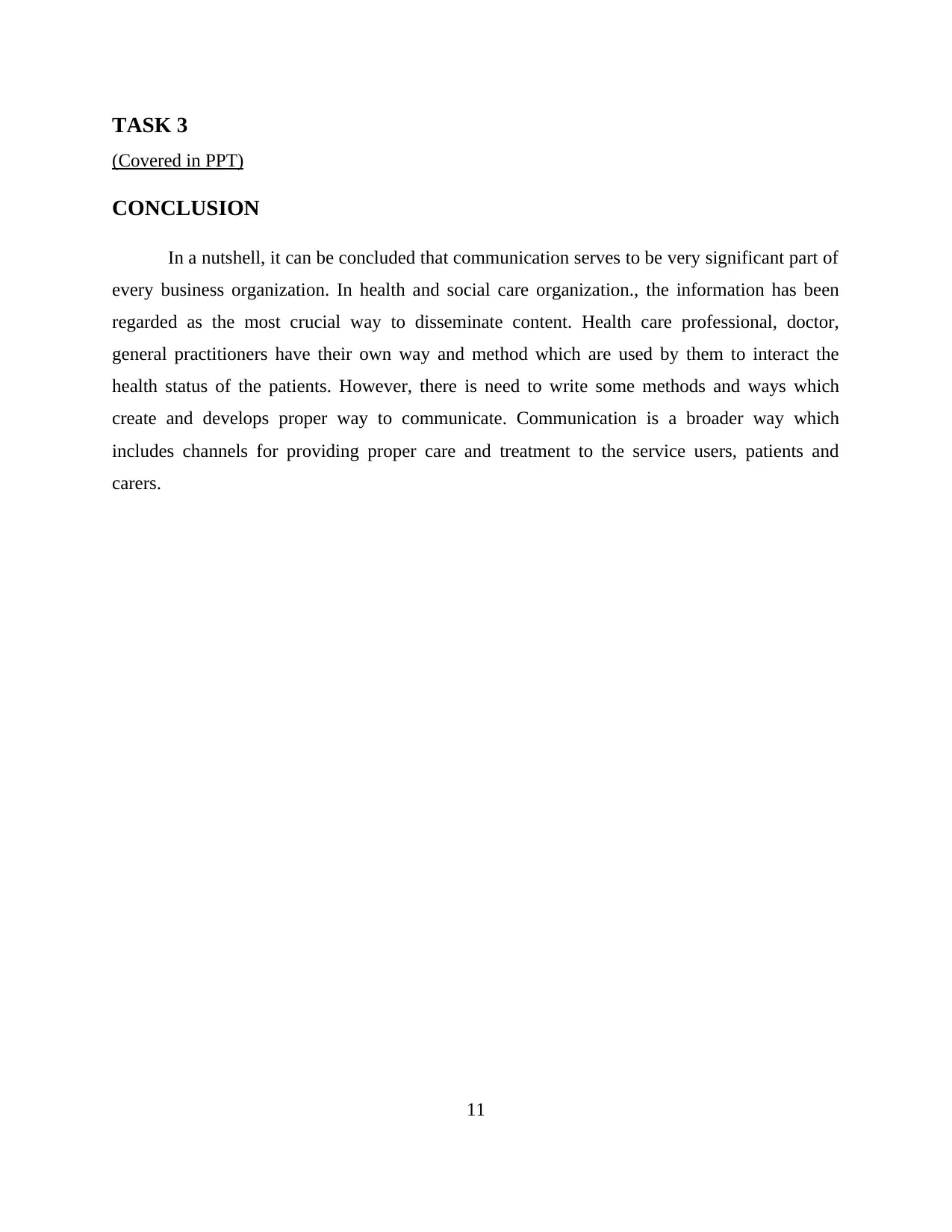
TASK 3
(Covered in PPT)
CONCLUSION
In a nutshell, it can be concluded that communication serves to be very significant part of
every business organization. In health and social care organization., the information has been
regarded as the most crucial way to disseminate content. Health care professional, doctor,
general practitioners have their own way and method which are used by them to interact the
health status of the patients. However, there is need to write some methods and ways which
create and develops proper way to communicate. Communication is a broader way which
includes channels for providing proper care and treatment to the service users, patients and
carers.
11
(Covered in PPT)
CONCLUSION
In a nutshell, it can be concluded that communication serves to be very significant part of
every business organization. In health and social care organization., the information has been
regarded as the most crucial way to disseminate content. Health care professional, doctor,
general practitioners have their own way and method which are used by them to interact the
health status of the patients. However, there is need to write some methods and ways which
create and develops proper way to communicate. Communication is a broader way which
includes channels for providing proper care and treatment to the service users, patients and
carers.
11
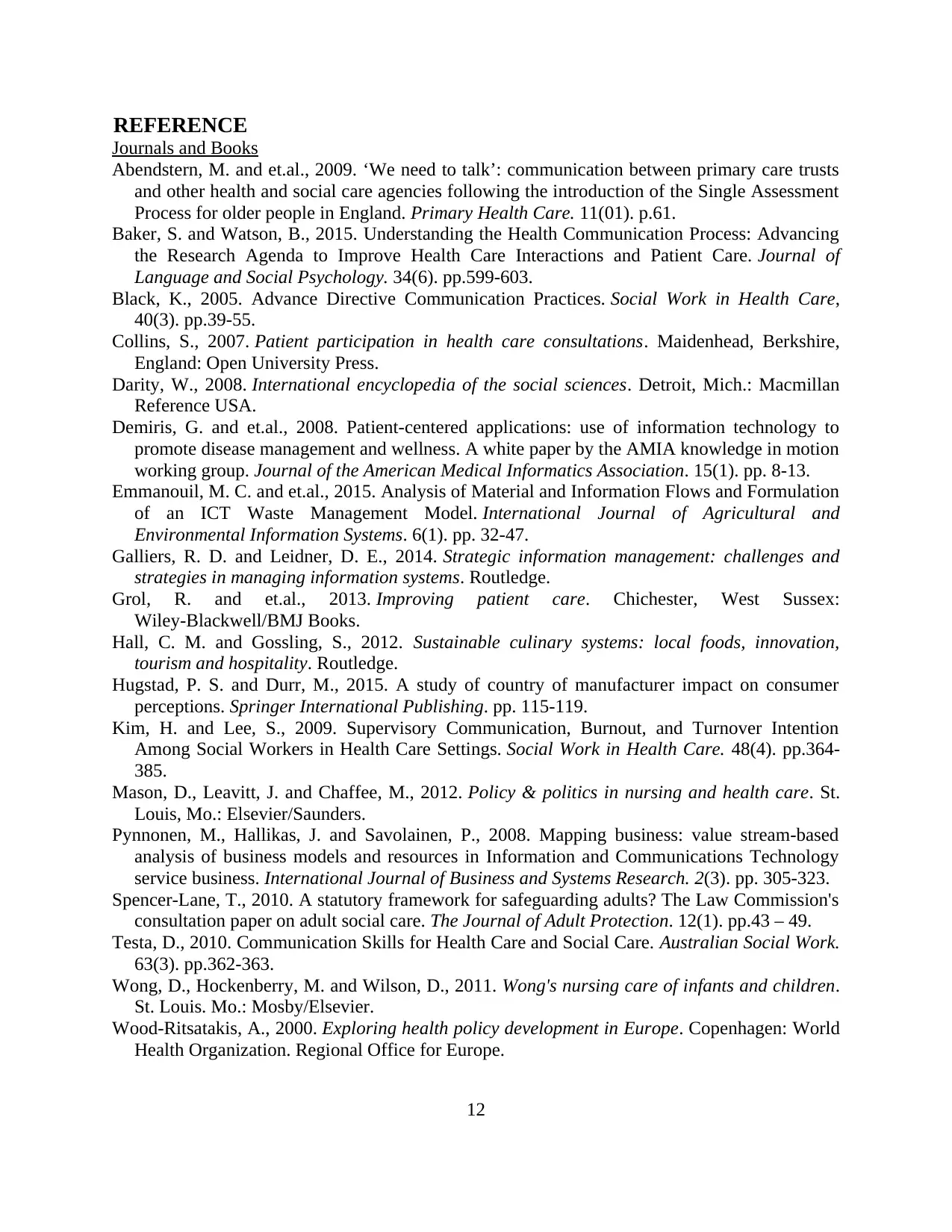
REFERENCE
Journals and Books
Abendstern, M. and et.al., 2009. ‘We need to talk’: communication between primary care trusts
and other health and social care agencies following the introduction of the Single Assessment
Process for older people in England. Primary Health Care. 11(01). p.61.
Baker, S. and Watson, B., 2015. Understanding the Health Communication Process: Advancing
the Research Agenda to Improve Health Care Interactions and Patient Care. Journal of
Language and Social Psychology. 34(6). pp.599-603.
Black, K., 2005. Advance Directive Communication Practices. Social Work in Health Care,
40(3). pp.39-55.
Collins, S., 2007. Patient participation in health care consultations. Maidenhead, Berkshire,
England: Open University Press.
Darity, W., 2008. International encyclopedia of the social sciences. Detroit, Mich.: Macmillan
Reference USA.
Demiris, G. and et.al., 2008. Patient-centered applications: use of information technology to
promote disease management and wellness. A white paper by the AMIA knowledge in motion
working group. Journal of the American Medical Informatics Association. 15(1). pp. 8-13.
Emmanouil, M. C. and et.al., 2015. Analysis of Material and Information Flows and Formulation
of an ICT Waste Management Model. International Journal of Agricultural and
Environmental Information Systems. 6(1). pp. 32-47.
Galliers, R. D. and Leidner, D. E., 2014. Strategic information management: challenges and
strategies in managing information systems. Routledge.
Grol, R. and et.al., 2013. Improving patient care. Chichester, West Sussex:
Wiley-Blackwell/BMJ Books.
Hall, C. M. and Gossling, S., 2012. Sustainable culinary systems: local foods, innovation,
tourism and hospitality. Routledge.
Hugstad, P. S. and Durr, M., 2015. A study of country of manufacturer impact on consumer
perceptions. Springer International Publishing. pp. 115-119.
Kim, H. and Lee, S., 2009. Supervisory Communication, Burnout, and Turnover Intention
Among Social Workers in Health Care Settings. Social Work in Health Care. 48(4). pp.364-
385.
Mason, D., Leavitt, J. and Chaffee, M., 2012. Policy & politics in nursing and health care. St.
Louis, Mo.: Elsevier/Saunders.
Pynnonen, M., Hallikas, J. and Savolainen, P., 2008. Mapping business: value stream-based
analysis of business models and resources in Information and Communications Technology
service business. International Journal of Business and Systems Research. 2(3). pp. 305-323.
Spencer‐Lane, T., 2010. A statutory framework for safeguarding adults? The Law Commission's
consultation paper on adult social care. The Journal of Adult Protection. 12(1). pp.43 – 49.
Testa, D., 2010. Communication Skills for Health Care and Social Care. Australian Social Work.
63(3). pp.362-363.
Wong, D., Hockenberry, M. and Wilson, D., 2011. Wong's nursing care of infants and children.
St. Louis. Mo.: Mosby/Elsevier.
Wood-Ritsatakis, A., 2000. Exploring health policy development in Europe. Copenhagen: World
Health Organization. Regional Office for Europe.
12
Journals and Books
Abendstern, M. and et.al., 2009. ‘We need to talk’: communication between primary care trusts
and other health and social care agencies following the introduction of the Single Assessment
Process for older people in England. Primary Health Care. 11(01). p.61.
Baker, S. and Watson, B., 2015. Understanding the Health Communication Process: Advancing
the Research Agenda to Improve Health Care Interactions and Patient Care. Journal of
Language and Social Psychology. 34(6). pp.599-603.
Black, K., 2005. Advance Directive Communication Practices. Social Work in Health Care,
40(3). pp.39-55.
Collins, S., 2007. Patient participation in health care consultations. Maidenhead, Berkshire,
England: Open University Press.
Darity, W., 2008. International encyclopedia of the social sciences. Detroit, Mich.: Macmillan
Reference USA.
Demiris, G. and et.al., 2008. Patient-centered applications: use of information technology to
promote disease management and wellness. A white paper by the AMIA knowledge in motion
working group. Journal of the American Medical Informatics Association. 15(1). pp. 8-13.
Emmanouil, M. C. and et.al., 2015. Analysis of Material and Information Flows and Formulation
of an ICT Waste Management Model. International Journal of Agricultural and
Environmental Information Systems. 6(1). pp. 32-47.
Galliers, R. D. and Leidner, D. E., 2014. Strategic information management: challenges and
strategies in managing information systems. Routledge.
Grol, R. and et.al., 2013. Improving patient care. Chichester, West Sussex:
Wiley-Blackwell/BMJ Books.
Hall, C. M. and Gossling, S., 2012. Sustainable culinary systems: local foods, innovation,
tourism and hospitality. Routledge.
Hugstad, P. S. and Durr, M., 2015. A study of country of manufacturer impact on consumer
perceptions. Springer International Publishing. pp. 115-119.
Kim, H. and Lee, S., 2009. Supervisory Communication, Burnout, and Turnover Intention
Among Social Workers in Health Care Settings. Social Work in Health Care. 48(4). pp.364-
385.
Mason, D., Leavitt, J. and Chaffee, M., 2012. Policy & politics in nursing and health care. St.
Louis, Mo.: Elsevier/Saunders.
Pynnonen, M., Hallikas, J. and Savolainen, P., 2008. Mapping business: value stream-based
analysis of business models and resources in Information and Communications Technology
service business. International Journal of Business and Systems Research. 2(3). pp. 305-323.
Spencer‐Lane, T., 2010. A statutory framework for safeguarding adults? The Law Commission's
consultation paper on adult social care. The Journal of Adult Protection. 12(1). pp.43 – 49.
Testa, D., 2010. Communication Skills for Health Care and Social Care. Australian Social Work.
63(3). pp.362-363.
Wong, D., Hockenberry, M. and Wilson, D., 2011. Wong's nursing care of infants and children.
St. Louis. Mo.: Mosby/Elsevier.
Wood-Ritsatakis, A., 2000. Exploring health policy development in Europe. Copenhagen: World
Health Organization. Regional Office for Europe.
12
⊘ This is a preview!⊘
Do you want full access?
Subscribe today to unlock all pages.

Trusted by 1+ million students worldwide
1 out of 13
Related Documents
Your All-in-One AI-Powered Toolkit for Academic Success.
+13062052269
info@desklib.com
Available 24*7 on WhatsApp / Email
![[object Object]](/_next/static/media/star-bottom.7253800d.svg)
Unlock your academic potential
Copyright © 2020–2025 A2Z Services. All Rights Reserved. Developed and managed by ZUCOL.





